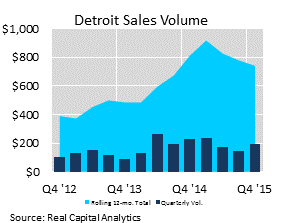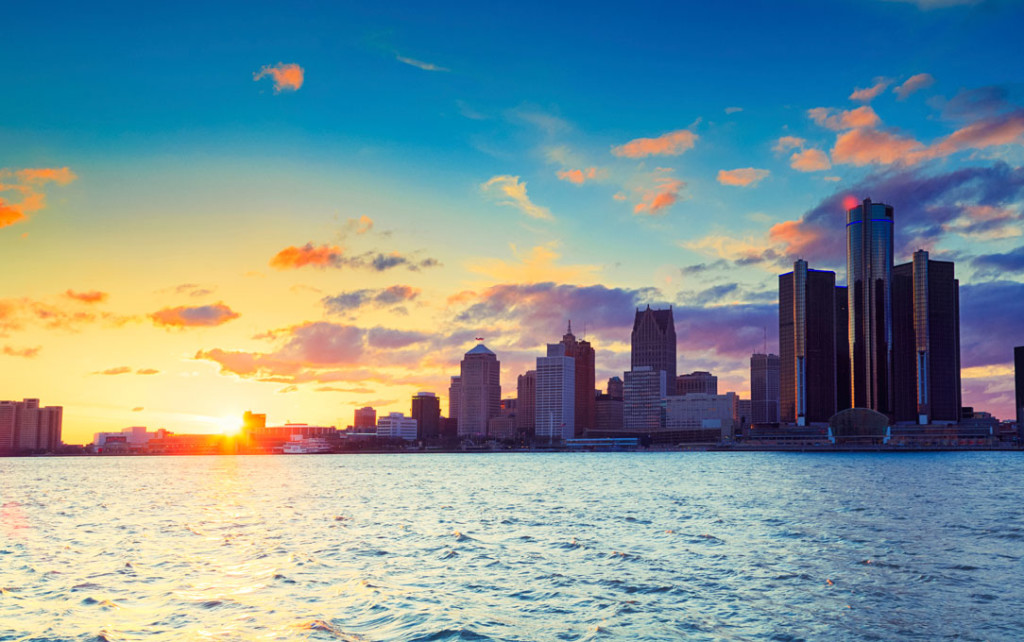The revitalization of downtown Detroit shouldn’t be ignored when evaluating long-term commercial office investment opportunities. While the turn-around is still very much a work in progress, this market offers significant upside with low barriers to entry.
Also: Threats and opportunities in the healthcare marketplace | Global investors say real estate will continue to shine
Detroit’s historic bankruptcy was key in wiping out $7 billion in debts the city couldn’t pay and began the long road to recovery with a new stability to attract investors. Led most notably by Dan Gilbert of Rock Ventures, several prominent developers and entrepreneurs have been steadily investing in and renovating the downtown core. While Detroit may no longer be accurately labeled “Motor City” – most of the Big Three auto plants have long left the city – efforts are underway to transform the city into “Tech Town”.
Plus: The industrial age | Playing with a full deck: why diversity is essential to success
Bolstered by a $55 million venture capital fund (Detroit Venture Partners) as well as Google’s establishment of a tech hub to aide startups in connecting with Silicon Valley investors, the early signs are positive. Among other notable achievements:
- Microsoft Ventures established a presence downtown in order to provide financing and technology to startup entrepreneurs.
- Amazon recently established a tech hub on several floors of a downtown office tower.
- Lear is opening a new innovation and product design center housing roughly 150 employees.
Detroit doesn’t need to supplant Silicon Valley as the cradle of innovation. But its economic future would brighten if it can establish a solid base that would reduce reliance on the auto industry in the way that Pittsburgh diversified itself from being the “Steel City” to a hub of research and innovation.
The momentum of the migration to CBDs that we are seeing around the country points to further upside in Detroit, as companies and labor pools are noticing the renovations. Quicken Loans moved thousands of employees from its former headquarters in the suburbs to downtown Detroit. Businesses have sprung up to cater to the new influx of corporate employees, including restaurants, cafes and perhaps the truest litmus test of successful revitalization – hipster bars.
The plan for revitalizing Detroit includes transforming key public spaces to make the area a pedestrian-friendly destination. The strategy is to focus growth in the downtown areas and then spread outward to the city’s peripheral neighborhoods. The robust traditional infrastructure network of rails, waterways and highways remains an asset, and the technology infrastructure is about to undergo a major upgrade. A newly launched startup, Rocket Fiber, has built a gigabit fiber ring in downtown Detroit that offers internet speeds roughly 100 times faster than the current standard capabilities, which could be key in attracting more technology companies. When factoring in state and local tax credits, purchasing and renovating existing office buildings is often not only less expensive than the cost of replacement, but lower than the cost of development when they were built 80-90 years ago. The added incentive of being able to acquire historically-significant architecture should be a compelling aspect as well.
Looking at some key office real estate metrics, these efforts look to be paying off. Vacancy rates have been trending lower for seven consecutive quarters while absorption has been positive four straight quarters. Class A asking rents are still below their historical average of $22.28/sf, so there is plenty of upside in that regard. Rolling 12-month cap rates have trended down from 8.0% at the beginning of 2015 to 7.5% at year-end, though remain above the U.S. average of 6.7%. The price per square foot has been hovering in the mid-$80 range compared to the mid-$200 average for the U.S.


While the recent improvements have been exponential, Detroit’s turn-around is certainly not guaranteed, as the city confronts substantial problems of poverty, crime, high property taxes and low education levels. Moreover, the decades-long exodus from the city continues, though it has been slowing. According to the U.S. Census Bureau, the annual rate of decline through much of the 2000s was 24,000, but has fallen to 7,500 more recently. The employment picture has been trending in the same direction. While Detroit city’s unemployment rate (10.7%) is double the national average, it is far below its peak of 28.4% in mid-2009.
The turnaround won’t happen overnight, but if you have the time and ability to hold onto an asset, the growth fundamentals supporting Detroit’s office market are headed in the right direction. With significant buy-in from government, developers, investors and name brand companies, the belief is growing that Detroit is America’s Comeback City.

 Colliers Insights Team
Colliers Insights Team

 Aaron Jodka
Aaron Jodka Sandy McDonald
Sandy McDonald Ronna Larsen
Ronna Larsen
 Marianne Skorupski
Marianne Skorupski
 Franklin Wallach
Franklin Wallach Verity Mosquera
Verity Mosquera